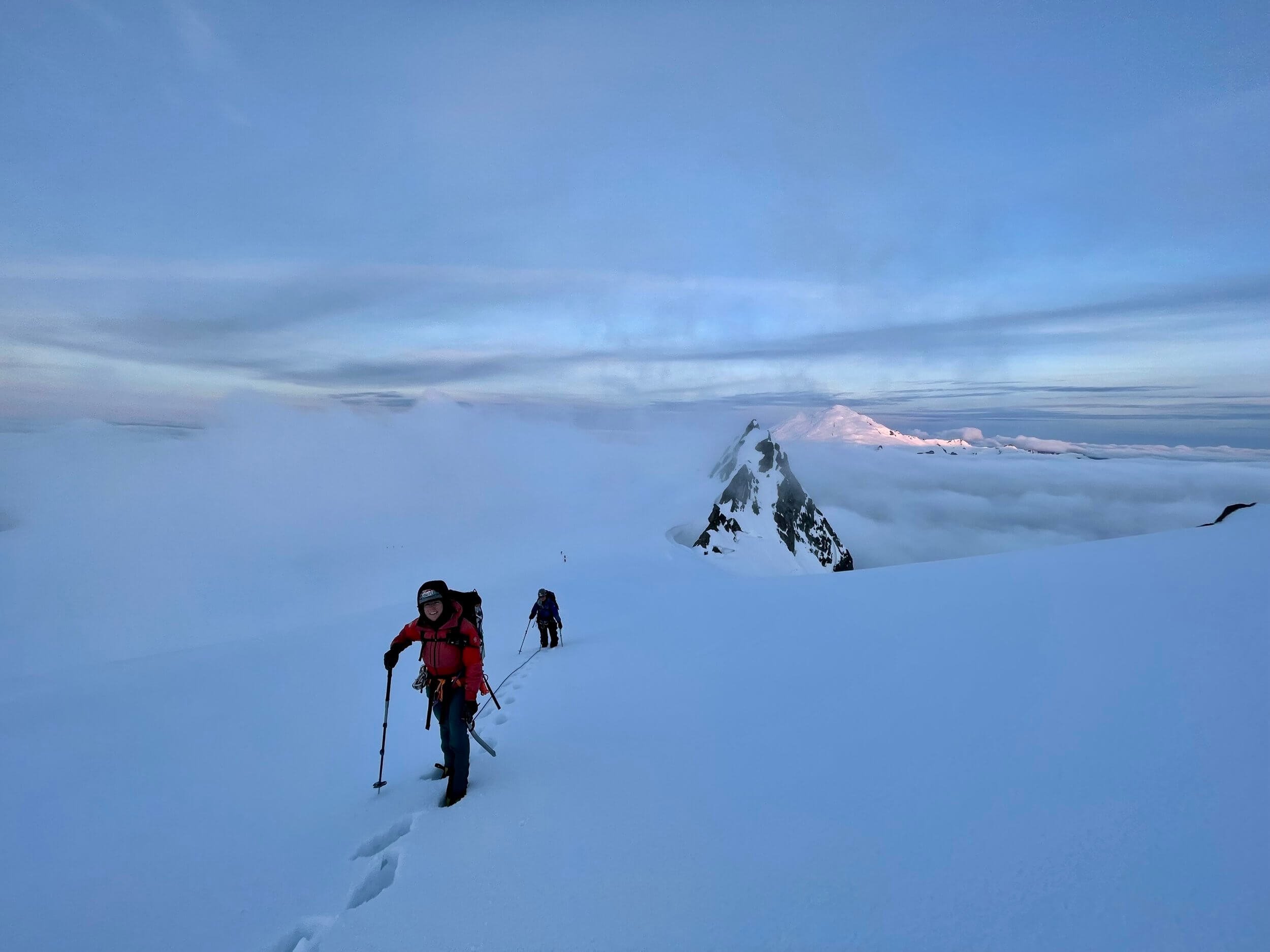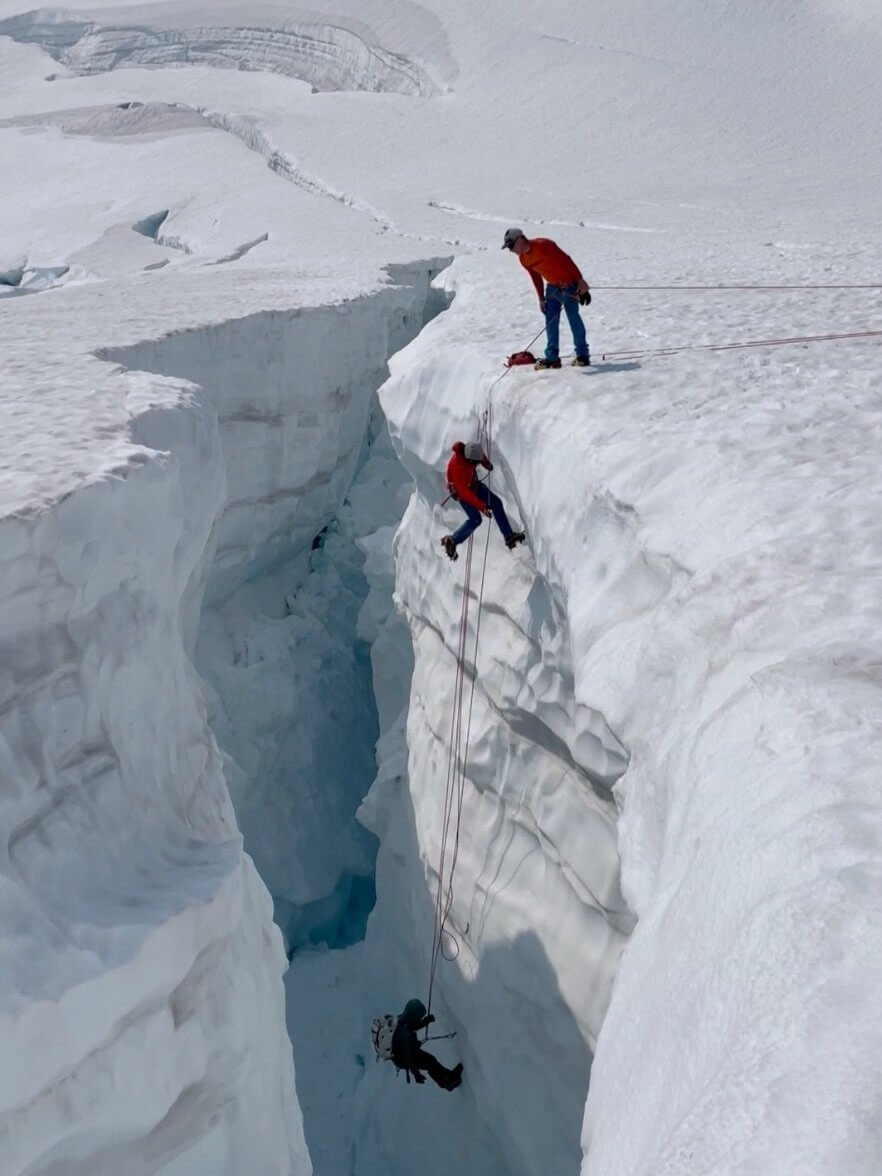
Learn Essential Mountaineering And Glacier Travel Techniques
The Introduction to Mountaineering clinic is designed for novice mountaineers looking to climb general or technical mountaineering objectives in glaciated terrain as an independent party. Skyward Mountaineering will help you develop a strong grasp on efficient and modern mountaineering systems with a focus on safety, a fast and light ethos and self-sufficiency in the mountains. This introduction to mountaineering course is offered on Mt. Baker in the Pacific Northwest, where we can access significant glaciated terrain to cover for prime instructional value. Throughout this 5-day intro to mountaineering clinic we will cover the following skills:
Equipment selection and packing an overnight climbing kit
Winter campsite selection and maintenance
Crampon and ice axe technique
Rock climbing movement
Glacier travel
Snow anchors
Rock anchors
Crevasse rescue
Belayed climbing and rappelling
June 23 - 27, 2025
June 30 - July 4, 2025
No previous climbing/mountaineering experience is required for the Intro to Mountaineering clinic.
Sea-Tac International Airport is the best option if flying into Washington for this program. A rental or personal vehicle is required as the trailheads are in remote areas.
The Intro to Mountaineering clinic is based out of Bellingham, WA where there are multiple hotel options and a great restaurant and brewery scene. During the overnight portion on the mountain we will be camping.
Climbers are responsible for providing their own personal clothing and equipment. Skyward Mountaineering may assist in supplying technical equipment with advanced notice. Please see recommended equipment list below:
-
Underwear: Should be comfortable, synthetic fibers will wick moisture away from the body. Bring one change of underwear to maintain cleanliness
Midweight socks: Mini-crew or crew length hiking socks for the approach
Heavyweight socks: Over-the-calf winter weight for superior warmth
Sun hat
Warm hat: Should be thin enough to fit under your helmet
Neck gaiter: Buff style, provides protection from the wind and sun
Trekking gloves: Optional, lightweight fleece for around camp warmth/ comfort
Softshell climbing gloves: 2 pairs recommended, one lightweight and one midweight (should be waterproof)
Lightweight top baselayer: Merino wool or synthetic fibers will wick sweat away, a sun hoody is particularly useful on the glacier. Lighter colors are preferred
Midweight top baselayer
Midweight bottom baselayer: For colder summit days and additional warmth sleeping
Shorts: Optional, for the approach on warmer days
Midweight fleece jacket: An integrated hood adds warmth and weather protection. You may choose to substitute this layer for an active insulation jacket during colder temperatures
Softshell jacket: Lightweight, should not be insulated, should have a helmet compatible hood
Hardshell jacket: Lightweight, non-insulated hooded jacket to provide full protection during stormy weather
Softshell pants: Midweight (non-insulated) with reinforced instep. Avoid overly baggy pants
Hardshell pants: Should have full side zips
Insulated parka: Down is lighter/more compressible and a hydrophobic treated down won’t “wet out” easily, though synthetic is also sufficient. Should have at least 175 grams of 700+ down 8ill or around 125g/m² synthetic insulation
-
Climbing backpack: Approximately 50 liters
Trekking pole with snow basket: 3-section collapsible, one pole should be sufficient
Approach shoes: Comfortable trail running/hiking sneakers
Rock climbing shoes: Comfortable for all day use
Mountaineering boots: Must be crampon compatible (with a front and rear welt) and a fully rigid shank
Crampons: Steel is required for durability and security in firm conditions, should be 12-point with horizontal frontpoints
Crampon pouch: Reusing a USPS Tyvek mailing package is a cost effective option. Some packs have an external crampon pouch which replaces this item
General mountaineering ice axe: A slightly curved shaft is more versatile, should have an adze
Climbing helmet: Must be UIAA certified
Harness: Must have a belay loop and at least two gear loops
Tubular belay device with round bar stock locking carabiner
48 inch (120cm) sewn nylon sling
Prusik loop: 3 feet of 6mm accessory cord tied into a prusik loop or a manufactured rappel backup
20 feet 6mm nylon accessory cord
3-4 Locking carabiners: Lightweight, screwgate is easier to operate than a triple-action carabiner
2 Non locking carabiners: Wiregates are less prone to freezing
Toothed camming device with an integrated pulley: Optional, device such as the Petzl Nano-traxion can be useful for crevasse rescue
-
4-season tent: Lightweight, single wall tents are preferable for their ease of packing and set up though rainy conditions may dictate a double wall tent for better waterproofing
Sleeping bag: 20 degrees Fahrenheit recommended with a compression sack sized for your sleeping bag
Sleeping pad: Inflatable pads are lighter, warmer, and more packable. Should have an R-value of 3 at a minimum
Personal toiletries
WAG bags: Typically, one bag is sufficient for two loads, plan accordingly
Toilet paper, hand sanitizer, and wet wipes
Bowl, spork, and mug
Overnight meals: (breakfast and dinner) Freeze dried meals are light and simple but may be difficult to digest, consider any "add boiling water" meal.
-
Sunglasses: CAT 4 glacier glasses with side shields
Small tube of sunscreen and SPF chap stick
First aid kit: Small, should include any personal medications
Kula cloth: Optional, antimicrobial cloth for people who squat to pee
Pee funnel: Optional, to facilitate easier bathroom usage in a harness for people who squat to pee
Hand warmers: Optional
Fully charged phone (headphones along with downloaded podcasts or a movie can be enjoyable in the evening)
Headlamp with fully charged batteries
External battery pack: Optional, bring charging cables
2 liters of water: A soft water bottle is more comfortable in a pack but care needs to be taken to not puncture it
High energy lunch and snacks: A healthy mix of fats, sugar, and protein for a full day of the on-the-go (leftover pizza or sandwiches are a great midday pick-me-up)

Includes:
5 days of instructional climbing with an AMGA certified Alpine Guide
Group climbing equipment (ropes, rock/snow/ice protection and anchor material)
Group camping equipment (tents, kitchen and fuel)
Does Not Include:
Additional expenses associated with a change in the itinerary
Travel to/from trailhead
Lodging
Meals
Guide gratuity






